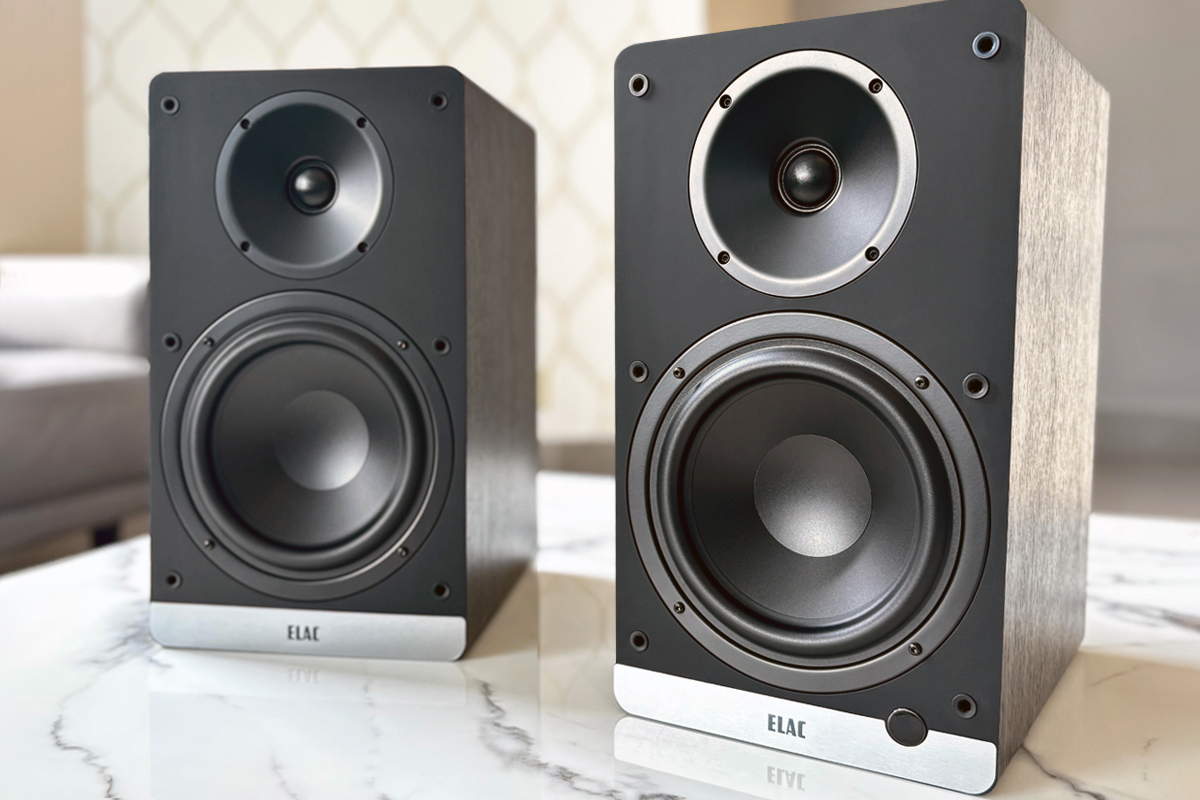German loudspeaker manufacturer Elac has made a number of appearances on this site, with products like the all-analog active Navis ARB‑51 bookshelf and Navis ARF‑51 floorstanding loudspeakers having been featured in reviews here. More recently we featured the Debut ConneX DCB41, the company’s entry-level powered bookshelf speaker system (US$699), designed at Elac Research in Ontario, Canada, and reviewed by Gordon Brockhouse in March 2023.
Released this past summer, Elac’s Debut ConneX DCB61 (US$899, CA$1383, £699, €799) is the bigger brother to the DCB41. On the day I expected the delivery of the DCB61 review sample, despite me being at home, the package was left at a bodega half an hour away (thanks FedEx!). I went to pick it up, and the shipping box was a lot heavier and more unwieldy than I’d been expecting. Hauling it home on that hot mid-August day was a chore I hadn’t anticipated, but I was excited to try it out and opened the box as soon as I got home.
Description
As is usual for loudspeakers sharing a product line, the industrial design is carried across from the DCB41 to the DCB61, resulting in a strong family resemblance—though of course the DCB61 speakers are bigger overall and feature larger midrange-woofers. Specifically, each DCB61 cabinet measures 13.5″H × 7.75″W × 9.6″D, with an internal volume of around 12 liters, more than twice as large as the roughly 4.5-liter internal volume of the DCB41, and the midrange-woofer diameter has been increased to 6.5″ from 4.5″. As you might expect, this provides greater bass extension (3dB down at 48Hz vs 66Hz).
But there’s also a significant upgrade hidden beneath the exterior of this new model that might not be so obvious at first glance, and it’s not well communicated by Elac. Where the smaller DCB41 is a powered system, this new DCB61 speaker system is fully active. This is an important distinction, as it means that rather than employing passive crossovers after its amplifiers, the DCB61 employs active crossovers implemented in DSP, followed by a separate amplifier channel for each driver. This approach can help with both sound quality and system efficiency. If you’re curious to learn more about this, I’ll invite you to read my recent feature article on active speakers.
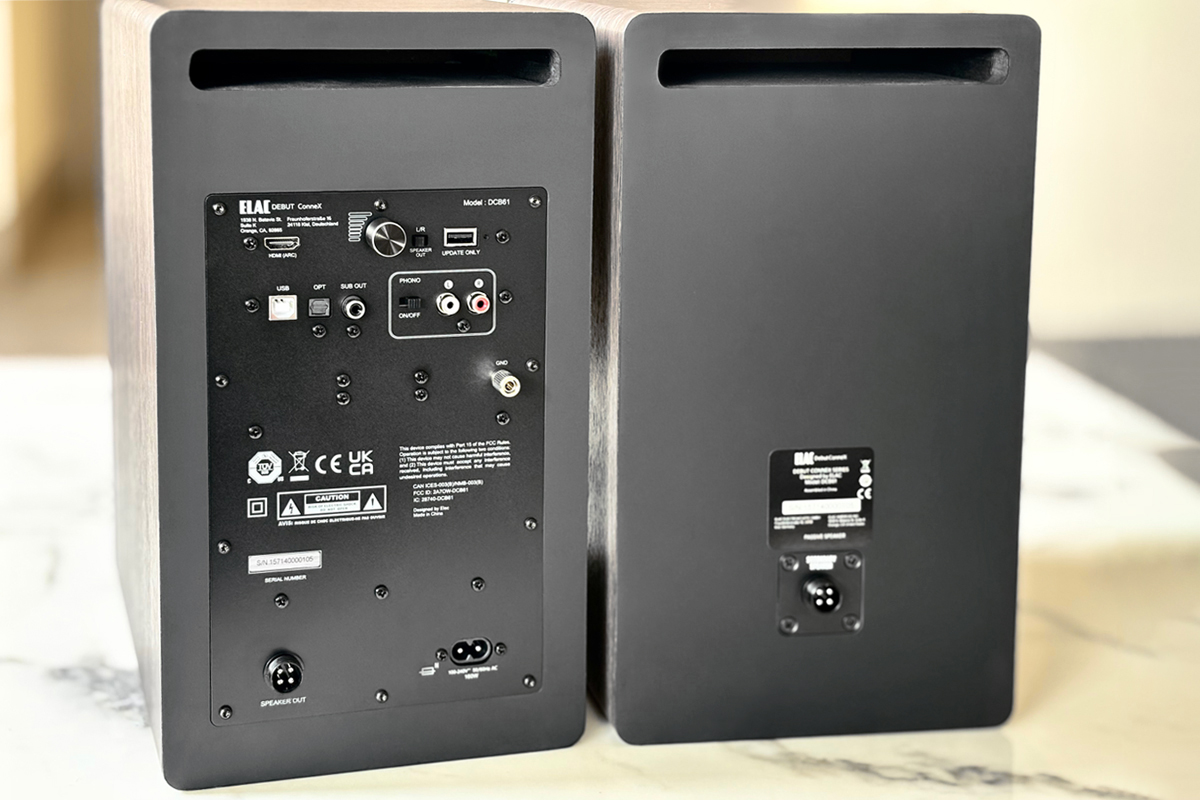
Despite being a fully active two-way system, all the electronics are housed in the primary speaker’s enclosure in the form of a rear-mounted plate amplifier, much like typical powered (non-active) speaker sets. What gives the game away, though, is that a four-conductor cable carries the amplified signal to the secondary speaker: one pair of wires for the midrange-woofer and another pair for the tweeter. This means that from the user’s perspective, you get the best of both worlds: the advantages of active crossovers and multiway amplification, and the simplicity afforded by only needing to supply mains power to one of the enclosures.
The review sample came with the Walnut finish applied to the top, bottom, and sides of the robust MDF cabinet. Black Ash, Olive Green, and Crisp White finishes are also offered. This two-way speaker system employs a conventional-looking polypropylene midrange-woofer, described as having “long excursion,” that sits flush with the front panel, with the four mounting screws visible. The tweeter is a 19mm soft dome, mounted in a custom-engineered waveguide with an outer diameter of approximately 4.4″, also flush-mounted to the baffle, and also held in place by four visible screws.
With all-black hardware and a semi-matte black finish to the front baffle, these speakers have a stealthy look, not drawing much attention to themselves, even with the grilles off. Speaking of which, the included grilles cover the full baffle, attaching with six push-fit pegs spaced around the perimeter of the perforated plastic frame, and are covered on the front with a smart, dark-gray woven fabric.
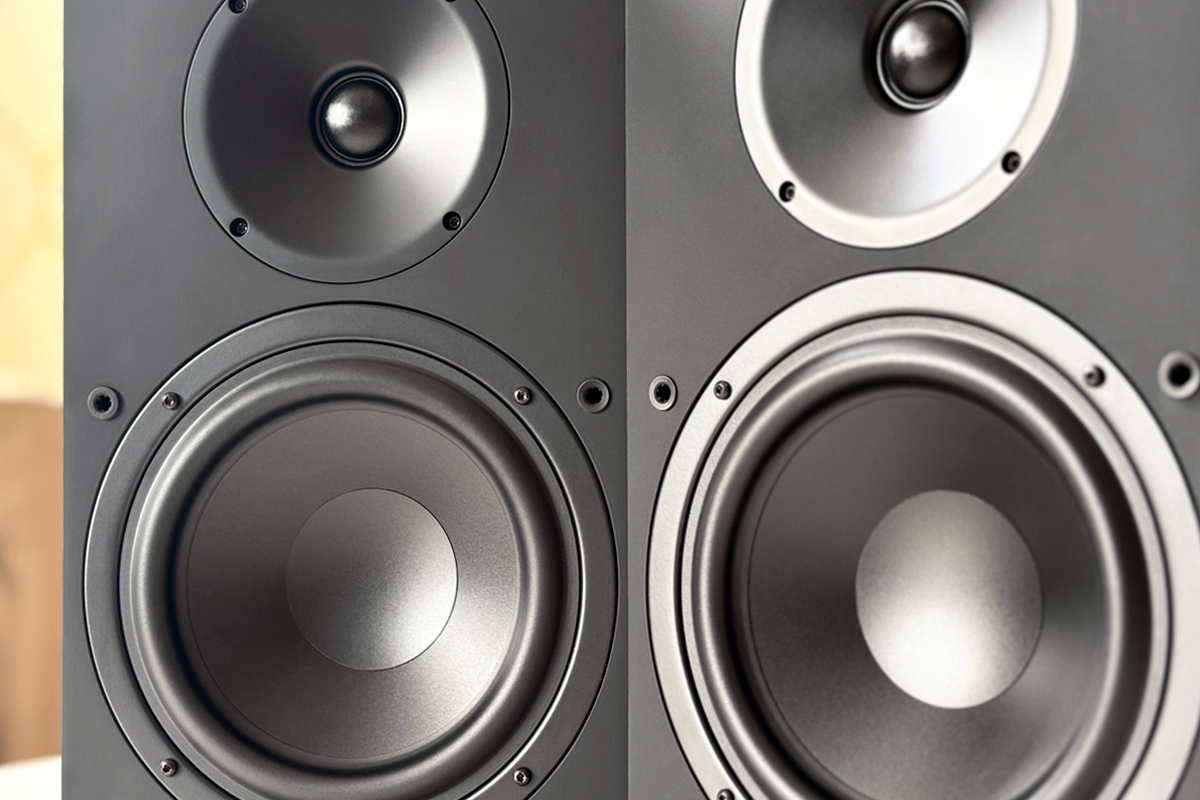
At the top of the rear side of each enclosure is what appears from the outside to be a simple slot port, but is actually a more convoluted S-shaped bass-reflex port, doubling over on itself within the cabinet. Peering into the slot port, it was possible to see some glue overspill from the speaker-box assembly on the inside of the cabinet.
The left and right speakers are connected using a nicely engineered 15′-long quad-core umbilical with terminations that have both orientation features and threaded locking rings to provide a secure fit. This is covered with a metallic braided sleeve that feels as though it is armored(!). The four-pin DIN-style cable connector employed here to carry separate high-level signals to the woofer and tweeter of the secondary speaker is called a GX16, a circular connector originally designed for use in the aviation industry, known for reliability and durability. It looks remarkably similar to the connector used in this same application on Klipsch’s The Fives active loudspeakers.
Onboard class-D amplifier power is specified as 160W RMS or 320W peak, following the marketing tradition of making the number of watts appear as large as possible. This translates to 60W for the woofer and 20W for the tweeter in each speaker. Input connectivity covers HDMI ARC/eARC (with Dolby Digital 2.1 support), USB-B (24-bit/96kHz maximum resolution), optical S/PDIF, a stereo pair of analog RCAs that’s switchable between line-level and MM phono, and Bluetooth (with support for the LC3 and aptX codecs). There’s also a single unbalanced subwoofer output on an RCA.
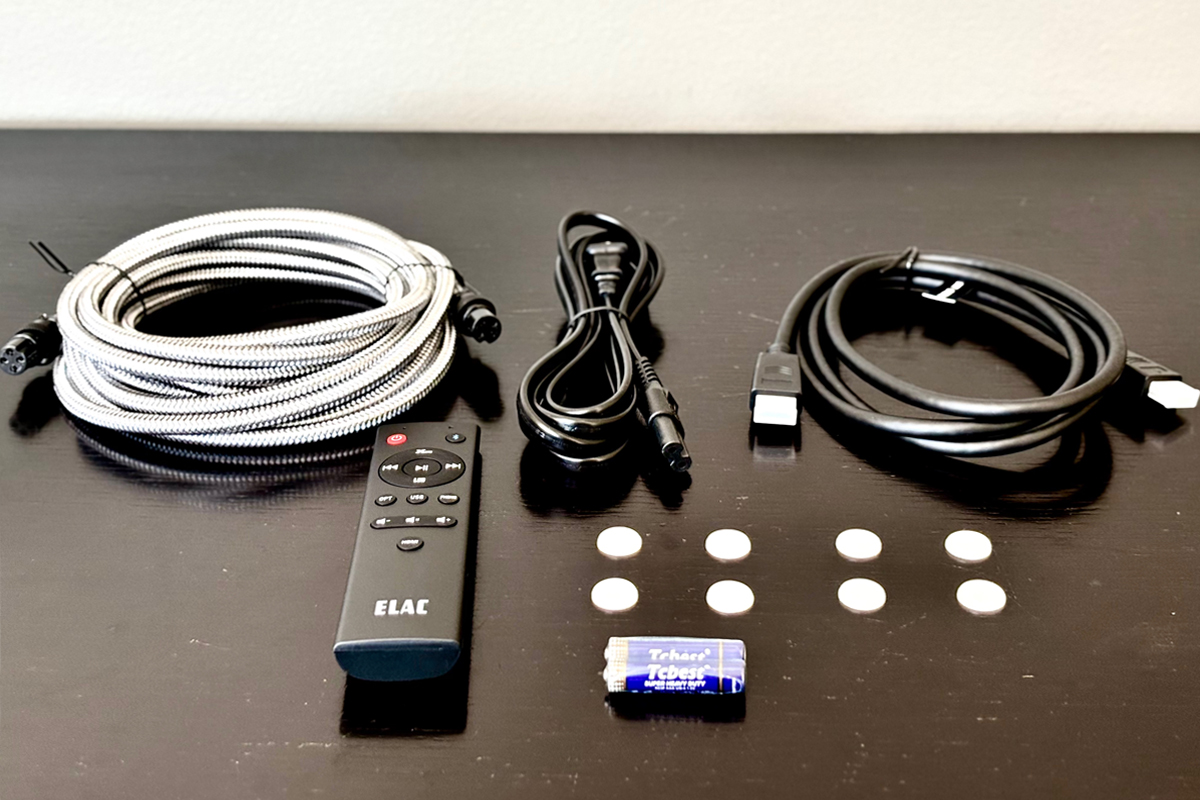
For some reason, Elac opted for the outdated USB Type B (aka printer cable) connector for the USB audio input. This is an odd choice over the now-ubiquitous USB-C, and the fact that no cable was included for this proved bothersome, because I didn’t have any old printer cables lying around and was forced to order one just for the review!
The rear of the primary speaker features a clickable rotary controller for volume and input switching that I never needed to use (the IR remote makes it redundant), but at least it’s there for when you can’t find the remote! There’s a USB-A port that’s strictly for firmware updates (more on this later), and a switch that assigns which speaker will handle which of the left and right audio channels. The panel is rounded out with a two-prong mains power socket at the bottom. On the front of the primary speaker is the circular IR receiver for the remote with a colored LED that indicates the selected input, visible with the speaker grille in place.
In use
There’s no power switch on the speakers, which means that unless you pull the power cord out, the system is either on or in standby mode. I considered this to be a limitation, though later I’ll share my intuition as to the reasoning behind it.
I installed the Elac ConneX app on my iPhone 15. To use the app, the device must be paired with the speaker via Bluetooth. The app’s functions include input selection, EQ, electronic adjustment for placement compensation, XBass bass enhancement, night mode, subwoofer filter, and auto-on toggle switches. Going through these features in turn, I found that most of them either didn’t behave as expected, or had behavior that wasn’t consistent with the explanations in Elac’s documentation.
The first issue I ran into was that my phone wouldn’t always automatically reconnect to the system via Bluetooth; as a result, the app wouldn’t see the speakers, so I couldn’t adjust any of the app-controlled settings. When I manually reconnected to the DCB61 with Bluetooth, it would assume that I intended to use Bluetooth as the audio input (which I didn’t). This meant an additional step of switching back to the input I had been using, with an unwanted break in playback.
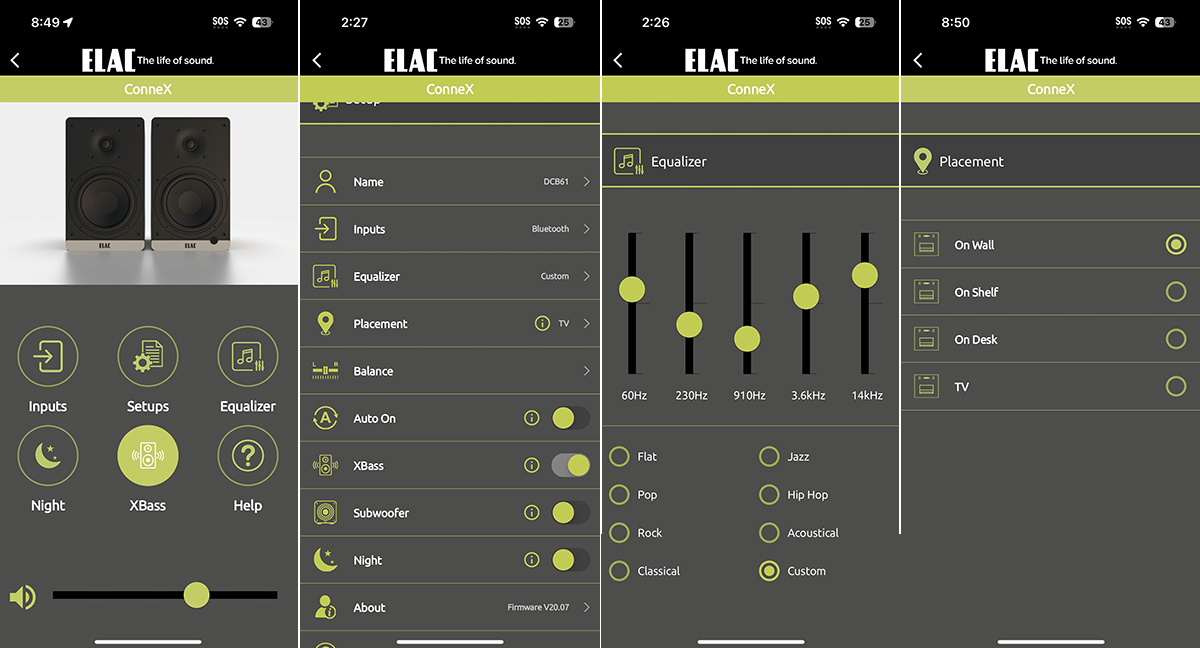
Next, the graphic equalizer is very basic and not particularly effective, with only five bands having center frequencies ranging from 60Hz to 14kHz. There are six static presets, one that is set to flat, and one user-definable custom slot. The six presets are very similar, all being slight variations on a theme. If you try adjusting any of the sliders without first choosing Custom, they will not respond. This means you can’t edit any of the existing presets as a starting point for your own setting. Instead, you have to manually duplicate settings in the custom slot first.
If you do end up creating a custom preset you like the sound of, it’s a good idea to save it somehow (as a screenshot perhaps); the system memory is volatile, and it will lose your settings if the power gets disconnected (this is likely why there’s no power switch). I also ran into an issue where the equalizer function would occasionally get stuck such that changing the preset had no effect, and the custom preset parameters were incorrectly displayed for any other preset selected.
Besides implementing the crossover in DSP, digital active speakers can utilize DSP for other functions, such as room-boundary compensation. For the DCB61, these user-selectable settings are accessible in the app, where you are presented with four options: On Wall, On Shelf, On Desk, or TV.
When I opened the help section of the app for an explanation of these settings, it explained that the default is Free/Standmount, which it says doesn’t change the tonality. Unfortunately, there is no such option listed in the app’s interface. I found that the speakers actually default to the On Wall setting, which, according to the in-app help, “lowers upper bass to compensate for rear wall gain.” We are also informed that On Desk lowers the mids around 200Hz, and TV slightly increases upper mids and air-band. Without measurements, we can only try to guess what the On Shelf setting does. The placement setting also gets forgotten if power to the system is interrupted.
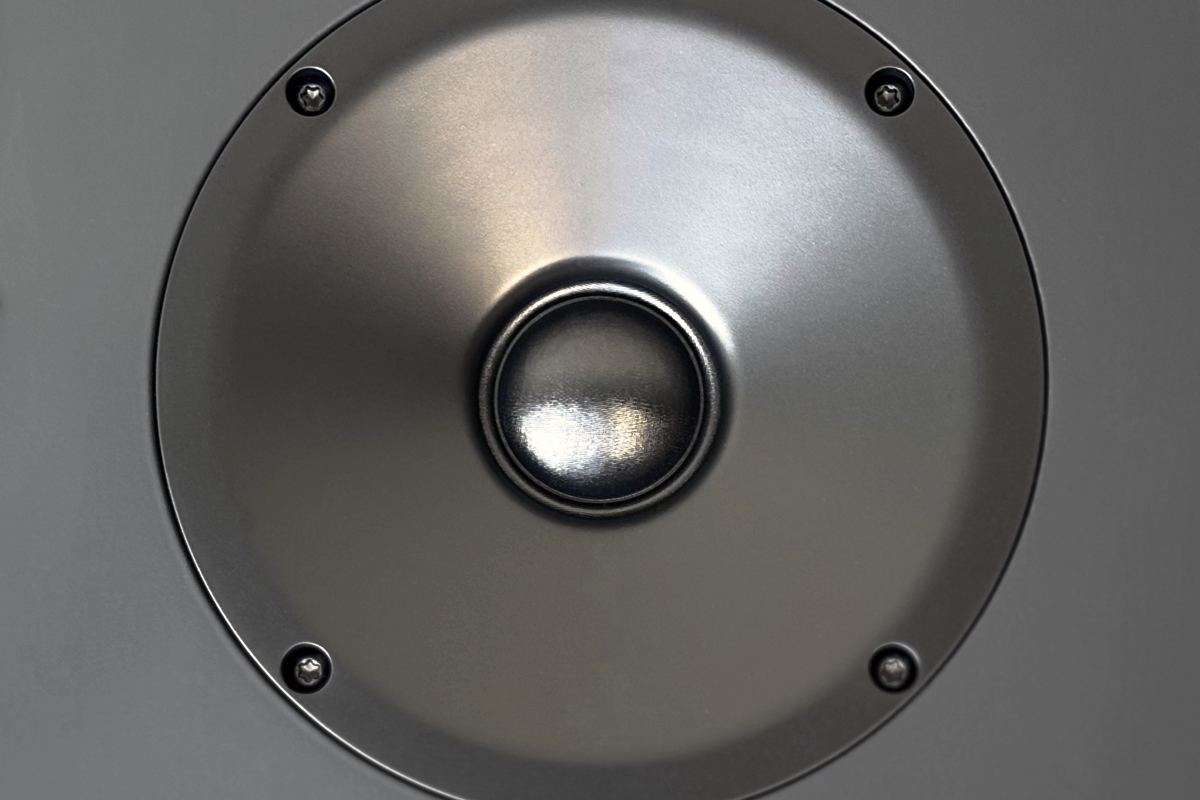
The balance control is improperly implemented—the left and right are identified incorrectly, so the control works backwards. Auto On would be better described as a power-saving mode. The speaker system automatically wakes when an input signal is detected, though it took around ten seconds to wake up when a signal arrived at the optical input. There was an audible pop that varied in loudness when the system went into standby mode, which happened around 15 minutes after playback ended.
The next control is a switch labelled XBass, which is on by default. Elac describes the XBass feature as its proprietary XBass enhancer, which delivers enhanced bass extension. I found the effect to be so subtle that I wasn’t convinced it was doing anything at all when I toggled the switch on and off.
Below that is a toggle switch labeled Subwoofer. I was expecting this to enable the subwoofer output at the rear of the primary speaker, but it turns out that the subwoofer output is always active regardless of the position of this switch. What the switch actually does is enable an unspecified high-pass filter to the speakers for the user to toggle manually when a subwoofer is being used. This setting also gets lost when power is interrupted. Compared to the auto-subwoofer-sensing implementation of the Fluance Ri71 powered loudspeakers, this arrangement seems primitive. There are also no bass-management controls in the app for controlling the output level or phase, or for applying filtering to the sub output—those parameters have to be set on the subwoofer.
Night mode could have been a useful feature for evening movie viewing, but again, the implementation is flawed. I was expecting some mild dynamic compression, and perhaps a gentle low-cut filter.
Instead, what it does is squash the signal with a heavy-handed compressor, removing most of the high-frequency information in the process, which makes everything extremely muffled and dialog more difficult to decipher. This requires dramatic EQ boosting of the high end to compensate, though the EQ is not very capable in this application, not to mention there’s only one user-definable EQ slot available. I found that switching the subwoofer toggle to on (without a sub attached) actually made for a more practical night-mode solution.
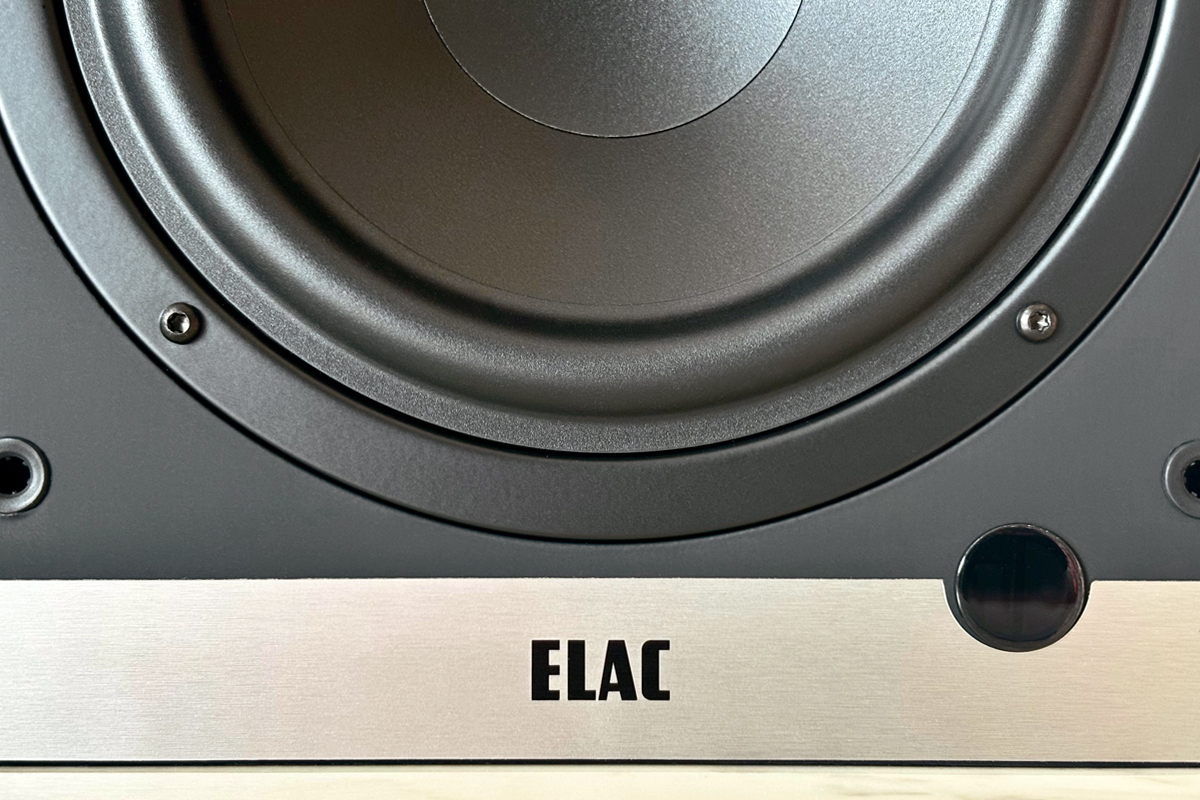
I ran into a few more odd quirks during the review period. For example, the status LED on the front of the primary speaker doesn’t react when you change the volume. And when you turn off said LED using the remote, it comes on again the next time you use the remote (to make a volume adjustment, for example), or if you change any settings with the app. This means if you don’t want the LED on, you’ll be repeatedly turning it off.
On more than one occasion when using the optical digital input, what I heard coming from the system bore only a passing resemblance to the signal I was feeding it. What I got was a down-tuned, bit-crushed version of the song I was playing. This I attributed to a clocking issue where the DCB61 would occasionally misread the incoming data on the optical port and play back at the wrong sampling frequency. The remedy for this was to reboot the system (otherwise known as pulling the plug!).
According to the Elac Connex app, my review sample was running firmware version 20.09. I hoped that a firmware update might fix some of the issues I’d run up against. Firmware update info for the system can be found on Elac’s support page, where it listed V20.7 as current. The update instructions specify that you will need a FAT32-formatted USB drive that’s smaller than 8GB to load the update onto the primary speaker. Unfortunately, I was not able to get the update to run from any of the three USB drives I had on hand that met the size-limitation criteria, so I was stuck with the firmware as loaded. It made me wonder why the update couldn’t be delivered over Bluetooth.
The sound
I placed the Elac speakers on the stands usually occupied by my KEF R3 Metas, 5′ apart and with front baffles 16″ from the front wall of my 11′ × 8′ acoustically treated den. A WiiM Mini streamer (all equalization disabled) was employed as a source device, connected digitally to the optical input of the DCB61, which was in its default configuration. I was initially struck by the speakers’ full-bodied, weighty sound. They produced a girthy low end that didn’t extend super low down, but provided a sense of scale to the music that went beyond my expectations, even considering the larger cabinet size. That impression quickly gave way to my observation that the bottom end dominated the tonal profile of these speakers, to the detriment of the rest of the spectrum. There was an absence of midrange presence, little clarity, and very limited detail retrieval in the midrange. But the top end was perhaps the most obvious issue to me—it was pushed back far enough that it seemed the tweeters were contributing less to the sound than I would have liked. Within minutes of powering up the system I started digging around the settings in the app to see what could be done to improve matters.
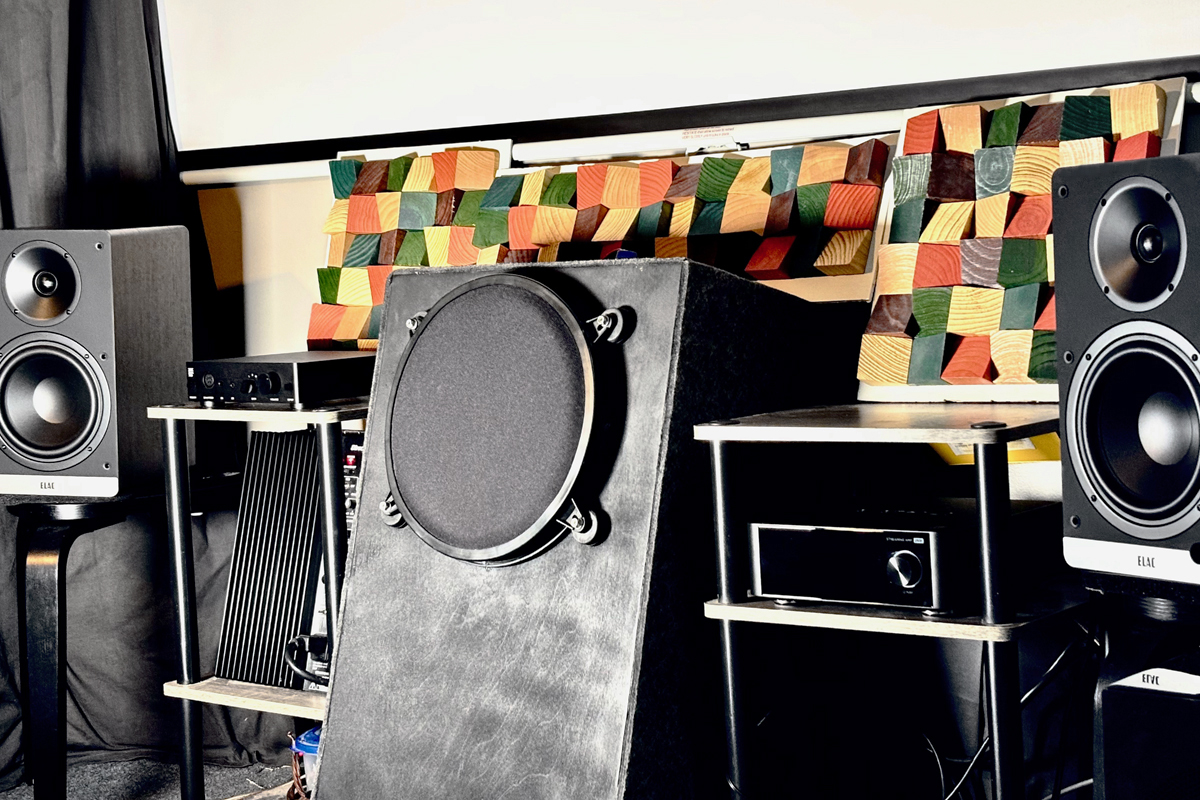
Among the placement settings, I found that the TV setting worked best in my space, and it seemed like an appropriate choice given that the rear of the speakers were only around 8″ from the front wall, under my projector screen. This brought about a minor tonal shift resulting in a slight improvement in midrange presence.
None of the EQ presets solved the major issues I was hearing, and, as noted, there’s not much variation between the available presets. One thing I noticed that they all had in common was a boost in the level of the highest-range slider (14kHz) relative to the 3.6kHz midrange slider. This didn’t mitigate the issue I was having with the missing top end, though, and the bandwidth of that 14kHz filter was too narrow to fully address the problem. A variable high-frequency shelf filter would have been more appropriate. Stereo width and spatial accuracy were especially impaired by the unrefined, dull-sounding tonal balance, making the waveguided dispersion control of the tweeter appear to be a wasted effort.
The EQ shape I ended up with included a big boost (+7) to the 14kHz band and a small push (+1) below that in the 3.6kHz band, but switching the preset in and out did not demonstrate as significant an improvement as I’d hoped. I concluded that the EQ tools provided were not adequate to remedy the deficiencies of the system, and pressed ahead with my listening tests anyway.
“Walking with a Ghost” from Tegan and Sara’s 2004 record So Jealous (16-bit/44.1kHz FLAC, Vapor-Sire / Qobuz) opens with a strummed acoustic-guitar pattern that sounded like the guitar needed new strings when played back on the Elac speakers. The track is marked by a stark lo-fi arrangement that spotlights the interplay of Tegan and Sara’s guitars and dueling vocal lines. But any subtlety in the midrange here was unfortunately lost, as the thumpy bass guitar overwhelmed the six-string guitar parts and sidelined the vocals for much of the song. The track’s minimalist production provides an intimate proximity, with subtle effects allowing breaths and inflections to stand out, but here they were passed over by deficiencies in the speakers’ indistinct midrange reproduction.
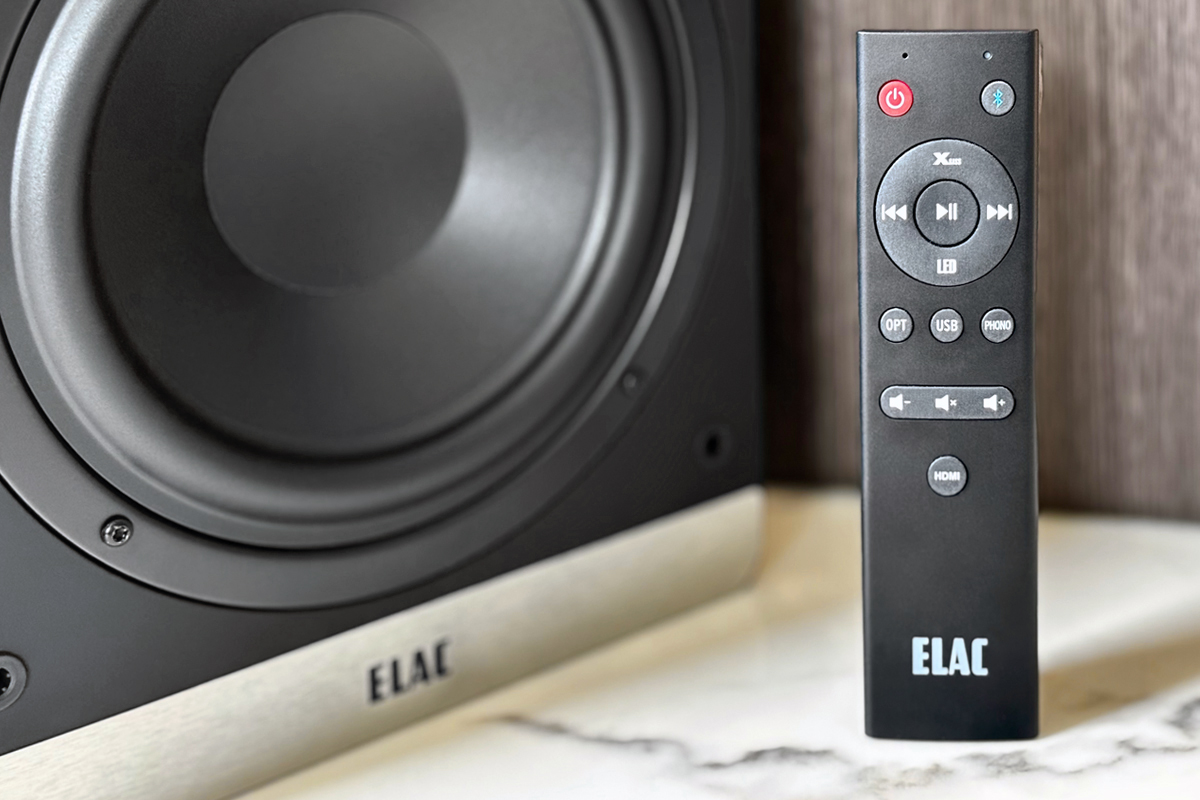
YACHT’s “(Downtown) Dancing” from Chain Tripping (24/44.1 FLAC, DFA Records / Qobuz) is an energetic electropop number, featuring a sleek fusion of synthesizers, sequenced beats, and processed vocals. This kind of track initially appeared to be a better fit for the DCB61’s strengths and weaknesses, built around highly synthetic instrumentation, with bright digital keys, dense drum programming, and funky electric-bass lines. However, the pulsing, quantized kick-drum beat made it clear that the forceful bass produced by these speakers was anything but clean, and was rather boomy and indistinct when scrutinized. Around those kick hits the speakers’ lingering fundamental resonance became quite difficult to ignore. What should have sounded like a taut, punchy pulse revealed a thumpy lack of bass control, leading to temporal smearing issues that both distracted and detracted from the experience of listening to the song.
Comparison
For comparison listening, I used my reference KEF R3 Meta speakers powered by a pair of Bang & Olufsen ICEpower monoblocks, fed from a Topping E30 DAC with the WiiM Mini (all equalization disabled) as a digital source device. The R3 Meta employs a 6.5″ hybrid aluminum woofer, the same diameter as the midrange-woofers used in the DCB61 system. Of course, the KEF R3 Meta differs in that it is a passive three-way design with a concentric mid and tweeter array, and it employs a much larger bass-reflex enclosure than the Elac system uses. I carefully level-matched the systems using a pink-noise track at -10dBFS to give me 75dB between the speakers, measured using the NIOSH SLM app on my iPhone.
“So Caught Up” from The Teskey Brothers’ Run Home Slow (24/44.1 FLAC, Glassnote Music LLC / Qobuz) is built on a foundation of warm, rich harmonies played on vintage electric piano and rhythm guitar, accompanied by a laid-back bass line. The song is driven by soulful instrumentation anchored in blues and classic R&B traditions. The recording combines analog techniques and a live performance to recreate the studio vibe of a bygone era, reminiscent of classic Motown and Stax records. This worked quite well on the Elac speakers, which enhanced the lo-fi aspects of the vintage-inspired production. The KEF speaker setup, in comparison, breathed life into the midrange, brought intimate detail to vocals and horn stabs, and provided transient attack to elements that sounded dull and indistinct on the Elacs. In particular, the ride-cymbal part in the bridge lacked the pinging quality of a real ride through the Elacs, but it was clearly there with the KEFs. The soundstage was opened up to be wider, livelier, and far more inviting in the KEFs’ rendering of the song.
Shaped by an understated yet evocative arrangement, Youth Lagoon’s “Football,” taken from Rarely Do I Dream (24/96 FLAC, Fat Possum / Qobuz) features flourishes of analog synths and subtle percussive elements to support the lead vocals and piano. These interact to create a nostalgic, dreamlike quality throughout the track. But it was the gentle, laid-back bass line that grabbed the most attention when I played the track over the Elac speakers. The bass part sounded a little saturated when played on the KEF speakers, but on the Elacs it entered into full-on distortion territory. An unpleasant buzzy quality accompanied every note of the bass line that was particular to the rendition by the Elacs, and I found that I had to turn the volume down a lot before it went away. The KEFs sounded clean and precise, though hardly clinical, in comparison, even at high volume.
Conclusion
There may have been some foreshadowing in my unexpected expedition to collect these speakers when they were supposed to be delivered to my home, because the review itself was, similarly, more involved than I’d anticipated.
As Gordon Brockhouse and other writers for this site have pointed out, reviewing for Simplifi involves much more than sitting back and listening. Due to the complex nature of these types of products, there’s often a whole lot of functionality to be tested. In this case, I wasn’t impressed by a lot of what I found, even though these ConneX speakers look great on paper.
It’s also important to point out that despite my enthusiasm for the concept, active speakers are not universally superior to systems based around passive ones. The DCB61 system serves as a reminder that in digital active speakers, the hardware can be let down by the software (and vice versa). In this case the software was the bigger letdown, mostly due to a companion app that’s not well thought-through and didn’t feel finished. The product didn’t make a good case for itself when I found things I believed to be bugs but wasn’t able to update the firmware, even when closely following the instructions for the update procedure.
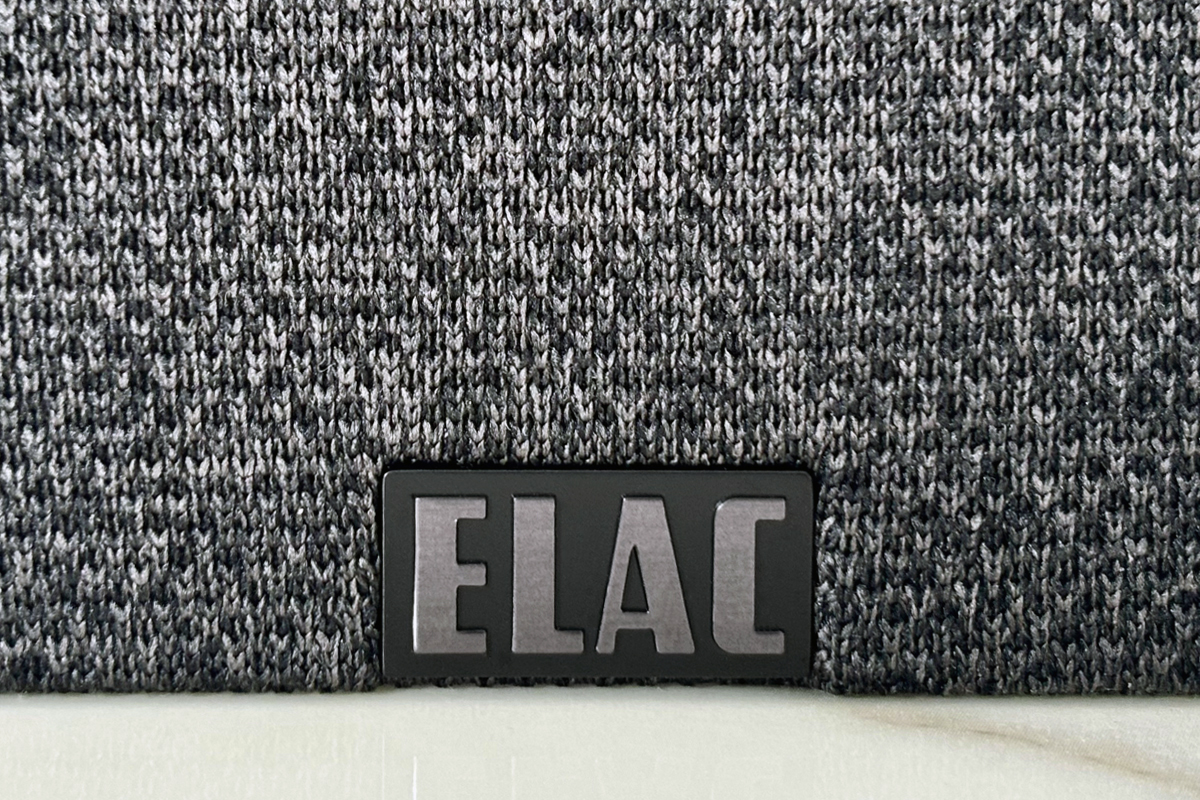
The hardware isn’t perfect, though, as the bass was overblown and unrefined to the point where obvious distortion could be heard on some tracks. The midrange lacked definition and clarity, and the top end was underrepresented. I wasn’t able to fully remedy any of these shortcomings using the placement and EQ controls in the companion app.
Even if the sound had been perfect, I’d still have reservations about recommending the Elac ConneX DCB61. If the firmware is updated to remedy the numerous issues I ran into, and perhaps to tweak the default sound shaping, I might have a more positive opinion of the system.
I’m going to go out on a limb and say that I don’t believe this system should have been released as a product with the firmware revision running on my review sample. I hope that the user-facing issues I identified can be resolved and that anyone who bought these speakers has more luck with the firmware update than I did!
. . . AJ Wykes
Associated Equipment
- Sources: Apple MacBook Pro (2019), iPhone 15, WiiM Mini
- DAC: Topping E30
- Speakers: KEF R3 Meta
- Power amplifier: Bang & Olufsen ICEpower monoblocks
- Subwoofer: Rythmik Audio 12″ Direct Servo
- Display: XGIMI Horizon Pro XK03H Smart 4K portable projector
Elac Debut ConneX DCB61 active loudspeaker system
Price: US$899, CA$1383, £699, €799
Warranty: Three years parts and labor, cabinets and drivers; electronics, one year
Elac Americas, Inc.
1938 N. Batavia St., Suite K
Orange, CA 92865
Phone: (714) 252-8843
Website: www.elac.us
Elac responds:
Thank you for your thorough review of the Debut ConneX DCB61. We’re sorry to hear that the system AJ received may not have been functioning as intended.
While we haven’t been able to reproduce the clocking issue or the popping sound during standby mentioned in AJ’s evaluation, we did identify the reversed balance control as an app-related issue. This has since been resolved in the latest update. At this stage, it’s unclear whether the unit’s malfunction may have influenced the acoustic performance AJ experienced.
We’d be glad to send you a replacement pair for a second look, should you be open to it. It’s unfortunate that timing didn’t allow us to get a new set to you prior to the review’s publication, but we truly appreciate the time and care you put into your assessment.
Chris Walker
Vice President, Product Development
Elac Americas, Inc.





